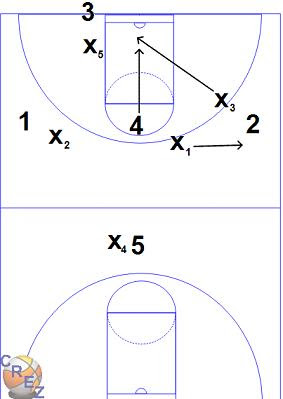The 55 full court press is a matchup press, similar to Rick Pitino's Kentucky presses. It is a gambling press that puts a lot of pressure on the first pass and as with most full court presses, your team should be more conditioned and more athletic than your opponents. Your players must be of the aggressive type, they must force the action and trap hard.
Some basic rules that Stringer uses before we get to the nitty gritty:
- no fouls, body checking, or silly reach in fouls
- no stripping of the ball, steals happen off passes only
- no trapping in the middle
- recognize "house on fire", trap is busted, hustle back on D
- communication, communication, communication
Stringer goes through a number of drills that she uses to get her players into the trapping mode. These include your standard full court zig zag drill, 8 second 1v1 drill, and a 3v0 into 2v1 half court trap drill.
55 Full Court Press Setup:
Basically, the 55 is 1/2 M2M and 1/2 zone defense. You play M2M on the short side, where the ball is likely to be inbounded. Here is what it should look like,

Primary Traps:
X5 guards the inbounds and is the only person to go sideline to sideline trapping and is also your weak-side defender in half-court transition defense if press is broken. Safe to say X5 must be long, lean, athletic. X4 is your safety, meaning nobody gets behind them, plays strong-side help in half-court if press is broken. X1 is the safety but on the ball-side. If the offense brings 4 players into the frontcourt, then X1 plays up. X1 always backs up the traps by being the primary ball stealer off bad passes and will pick up the ball if the press is broken. X2 is usually the first person to trap, picking up the first person on the ball-side. The goal is for X2 and X5 to set that first trap closing out the sideline. If O1 manages to get up the sideline, X1 should pickup and not allow middle. X3 zones up opposite the ball-side.

On the ball reversal, X5 is the only one to hustle over to cover the first pass, then shift to re-trap on the other side with X3 once the ball is reversed,

Deny Middle:
The weakness to this along with most presses is if the ball is attacked through the middle of the floor. Therefore, it is imperative that your players know how to deny the middle. In this example, a common press break is the 1-3-1 setup. What happens here is X3 and X1 will execute a jump switch. As O4 makes the move to the middle, X3 should anticipate and move to deny that pass. X1 will shift over and take X3's area,

Summary:
As with the Pitino matchup press, there are several more run and jump scenarios that Stringer goes through depending on whether personnel you are facing or against specific press breaks. This is a very aggressive press. When Rutgers used it in 2007, they were athletic and quick and therefore the risks they took ended up having big payoffs. When their talent changed though, Stringer had to stop using it. If you have a couple of long lean athletic forwards to go with a pack of jitter-bug quick guards, this is the perfect full-court press to use.
If you want the full description of this press, then you should get Vivian Stringer's DVD on the 55 Full Court Press. Discuss this and the rest of your favorite basketball topics at the X's and O's Basketball Forum.
No comments:
Post a Comment
Note: Only a member of this blog may post a comment.